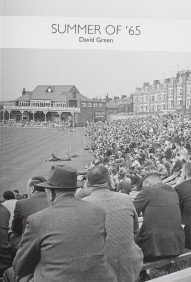Summer of ’65
Martin Chandler |Published: 2015
Pages: 160
Author: Green, David
Publisher: Max Books
Rating: 4 stars

The diary of an English county season is a relatively new genre in cricket books. As far as I can see A Diary of a Cricket Season by Bob Willis, published in 1979 was the first, although in 1946 and 1947 the Anglo-Irish writer Terence Prittie had written books about Lancashire’s first two post war seasons which were not far from the genre. Since then such books have become quite common, and indeed the publication of such an account on behalf of the summer’s County Champions has become almost de rigueur in recent years.
Much rarer is the appearance of a diary type account of a long past English summer, and in fact I can only readily think of two. Both books, coincidentally, were published exactly fifty years after the season they describe. The first was Ronald Mason’s 1970 published Plum Warner’s Last Season, a celebration of Middlesex’s Championship summer of 1920. David Green has chosen the same anniversary, although a rather different sort of campaign. In 1965 the Lancashire side of which he was vice-captain were a disappointing thirteenth.
Despite its originality Green’s book is not, bizarrely, the first book written about the Lancastrian cricketing summer of 1965. That was the same publisher’s superb Mods and Blockers, a rather different sort of book, but very much inspired by David Green’s batting, and indeed Green was of considerable assistance to author Colin Evans. A Handful of Confetti, a sort of an autobiography Green wrote in 2013 has also reminded readers of Green’s unique feat from 1965, that of scoring more than 2,000 First Class runs without even a single century. His highest score was 85.
After his retirement from the game Green wrote about cricket and Rugby Union in the Daily Telegraph. Sadly I recall nothing of those press writings, and as far as I am aware, other than a volume in the Christopher Helm county history series on his second county, Gloucestershire, Green did not write a book prior to his retirement. The quality of Summer of ’65 and A Handful of Confetti serve only as a source of disappointment that he waited until he was over 70 before venturing into print on any sort of autobiographical project.
In Summer of ’65 Green continues from where he left off in his previous book, in terms of selling himself short. His reader is repeatedly told Green couldn’t play spin, and that he struggled against the best pace bowlers. All things are comparative of course, but if Green really wanted to put forward a convincing case in support of his own shortcomings he really shouldn’t have included all the season’s scorecards in the book. Time and again it is clear that it was DM Green who held Lancashire together.
The book’s strength is Green’s talents as a storyteller and his ability to concentrate on what is of real interest to his audience, rather than a series of dry and uninspiring memories. We learn how six days a week cricket worked, and how county players kept their sanity. There are not a vast number of words in the book, but time and again Green describes his teammates and opponents extraordinarily well. Men like Fred Titmus and Jack Flavell are brought to life, and there are many entertaining stories. That of David Lloyd’s debut is one, and it was good to finally know why Hampshire pace bowler ‘Butch’ White is on the undistinguished list of names of bowlers who have been no-balled for throwing – his inclusion is entirely due to Green’s sense of humour.
And what of the cricket? It was certainly slow going, bowlers dominating a damp season in an era where wickets were uncovered. That, of course, makes Green’s achievement all the more impressive, but that is not a point he dwells on. Lancashire had some fine seam bowlers, Brian Statham, Ken Higgs, Peter Lever and Ken Shuttleworth, past, present or future Test players all, but the main problem was that such was the length of Lancashire’s tail one or other of them, and none were notable batsmen, had to bat at seven. The top order was none too reliable either, apart from Green only former Test man Geoff Pullar offered any real experience. County cricket was an interesting game then though, as were the travel arrangements, the socialising and the way the game was run, and very little would be familiar to the 21st century player or supporter.
To Lancastrians of a certain age Summer of ’65 is most certainly five star stuff but, I suppose, I do have to accept that the book won’t be of universal appeal, so I will rate it as only four, but reluctantly. A word too about the production, as the book has been very attractively designed, and the leather bound and multi signed limited edition is a credit to the publisher and, at a mere £35, very reasonably priced and, I believe, still available.






Leave a comment